
13 minute read
Braking checking
W O R D S : M A X S I L V E S T E R P I C S : G A L F E R
G1310 ON TEST

It’s one thing testing brake pads, but a wholly different thing understanding how they’re made. Max bagged the golden ticket to do both at Galfer’s HQ.
Going fast is one thing… but knowing you can stop is arguably even more important, in my book. Especially so when you’re on track and there are plenty of tyre walls littered around. Yep, stopping quick should be right at the top of your wish list, and to help you in that process Spanish stopping sensations Galfer have got something that should be right up your street.
Founded in 1952, this year marks the 70th anniversary for the tried-and-tested top tier braking manufacturer, sharing the landmark with The Queen’s Platinum Jubilee, and to celebrate, Galfer is launching a new sintered compound formula for its racing brake pads… the G1310 compound. It’s exclusively made for track use and racing, and has been developed alongside championship-winning supported riders (the likes of Marco Melandri, Lorenzo Baldassarri and Gabriel Rodrigo). This state-of-the-art pad compound is the result of many years of research, development, and testing, specifically designed for competition at levels such as the multiple classes at MotoGP and World Superbikes.
The pads themselves boast great initial deceleration and progressive braking thereafter, making them ideal for track riding where you’re chasing precious tenths of a second. Along with this, the features of this
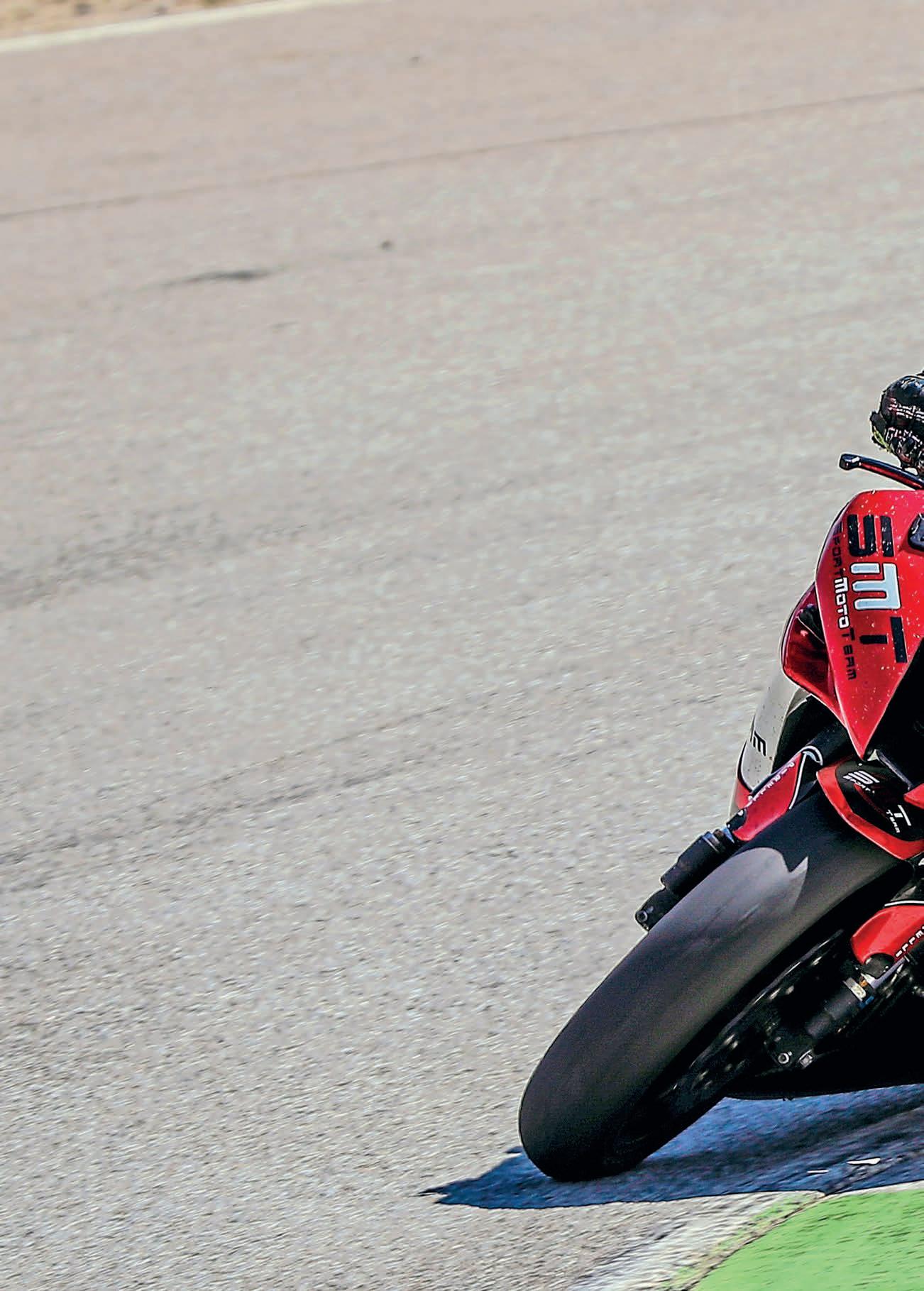


Not your typical production line...
compound include great stability throughout the duration of a race, and the ability to bed in fast and work well under all temperatures and conditions, while being non-tooaggressive on the discs.
Now, I could just go through a factsheet and write everything these pads say they can do, but if you’re anything like me you’ll be curious to know whether the product lives up to the hype. Luckily, I got the chance to fly over to the company’s HQ in Barcelona and visit the place where the pads are produced, before putting them through their paces around a race track. Having made my way to the swanky base, I got my first look and feel of the products… which on face value mirrored any other brake pad. But after firing a few questions to Sandra, who is part of the brand’s R&D team, I soon learned these pads are anything but conventional. She told me the project had taken three years to get to this point, explaining: “We have been involved with racing and in competition for many years and our pads have shown a very high modular ability; this was our best characteristic.
“In time we have found that some of our riders, especially the younger ones, were demanding more of an on-off characteristic, which is typical of what

WHO IS GALFER?
Established in 1952 by Maffio Milesi, Galfer provided drum brake linings and clutch discs for Seat as well as developing the first drum brake linings for motorcycles. From there it moved on to create disc pads for the Seat 124, embarking on the disc brake pad journey.
As the second generation of Milesi took over, Galfer continued to create brake linings and first put together a catalogue of brake pads in 1980, consisting of 45 products and composites. The company kicked off in the 1990s by completely discontinuing the use of asbestos for manufacturing brake components, creating and registering a patent for its very own ‘disc wave’ design which is still used to this day, and establishing Galfer USA in California, continuing to start the development and manufacture of sintered metal compounds in the 2000s.
From there onwards, Galfer has produced an incredibly wide variety of products, while continuing to implement better quality systems, recently becoming ECE R90 certified.
The brand’s products now range from performance racing parts to components for sportive and custom motorcycles, components such as the new CUBIQ style disks, or even the skull-shaped discs, a really stylish look to your custom bike.
Unlike its braking products, the innovation and development shows no sign of stopping. With the introduction of its new compound, it’s exciting to think of what will come next.
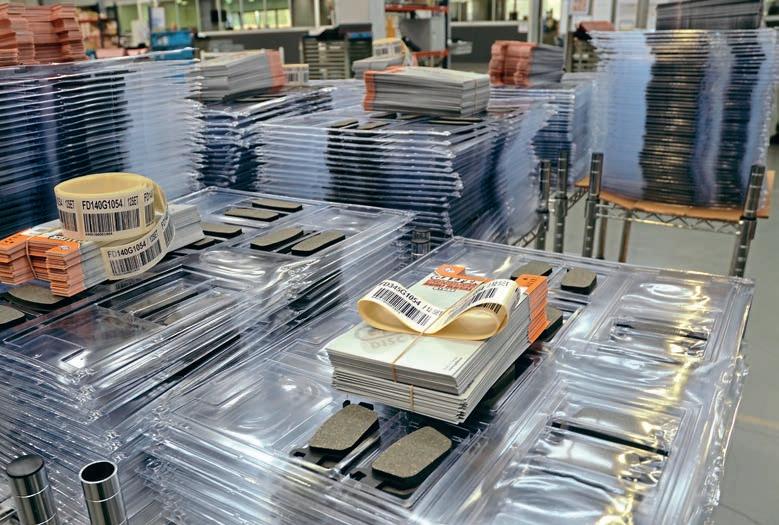

Do not enter!

Brake pads, anyone? Products are tested, monitored, and rated.
we’ve seen from our competition. Our riders were asking us for a pad with a bit more of an on-off behaviour, but one that maintained the modular ability.”
To someone who knows nothing about making world- class brake pads, that all sounded simple enough, but Sandra’s take on the process highlighted the significance of the challenge: “It is very complicated to make a pad with very specific characteristics. On a roller sintered pad, you have 10 to 12 different components. On an organic or semi-metal pad, you can have up to 25 different materials. When you only have two materials, it is very easy to know what will happen when they go up in temperature; you can calculate the outcome.
“When you have three materials it is a bit more difficult, but you can still find the end result easily. But when you have 10 to 12 different components, it is very complicated. When a pad is cold, the components can act differently to when the pad is warm, or warming; these behaviours make the process very difficult to control.
“Making a braking pad is a mix, it’s a very big part of science mixed with a part of art, but most importantly, experience plays a key part in the development. Right now, we have an electronic microscope, and any device
ON AN ORGANIC OR SEMI-METAL PAD,
YOU CAN HAVE UP TO 25 DIFFERENT MATERIALS.


They even come in a fancy box...
needed to know and understand the composition of a pad, but even with those kind of tools, I’d say experience is more important. The machines we use to get the composition know what to put in; the machine knows that the pad has carbon, iron and copper, but you won’t know what the behaviour of the composition will be when they are together, especially in temperature.”
The more we spoke, the more I came to appreciate the magnitude at hand when producing the G1310. It was a massive undertaking, consuming huge amounts of hours, money and expertise. But had it all been worth it? Had Galfer categorically achieved the goals it’d set out for? It sure felt so, but I was encouraged to find out for myself around the awesome Parcmotor race track. To do so, a huge spectrum of machines had been lined up, ranging from a KTM RC 390 to a race-spec R1, all fitted with Galfer’s G1310 pads.
Because I race a Yamaha R6 in the National Junior Superstock series, I figured my starting point should be on an R6 that was ready and waiting. I’m pleased I went for something familiar, because the track was anything but, being super-big, blind, and ballsy… with a sprinkling of horrendous bumps just to keep things interesting. With a handful of laps in the bag, my attention could turn to the brakes in earnest, which I tested like I would any track-spec brake pad… with no holding back. I wanted to know how they behaved under all the different rigours that track riding demands, from aggressive squeezing on the lever and working out the initial bite and consistency of the performance to how





The finest frisbees you’ve ever seen.
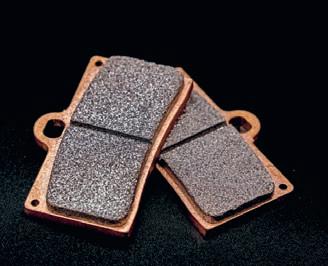
much feel they offered when trailing deep into bends.
Staying out on track for 25 minutes at a time, I felt not a single change or loss of performance, even with the 32-degree heat being a factor. I was incredibly surprised with the stability of these pads, from initially jumping on the brakes and getting tipped in, and even still applying pressure deep into hairpins… I didn’t have a single problem. In one of the circuit’s big braking zones there are some pretty extreme braking bumps, though I still felt comfortable to squeeze as much as I could out of these brakes while regulating pressure to keep the back of the bike down.
To say they impressed me is an understatement, but I couldn’t help wondering if a bit more speed would throw

A cut above...


Above: Brake pads are made from a blend of materials.
SANDRA BUENO: WORD FROM THE TOP
While we were over there, we caught up with Galfer’s head of break pad R&D and threw a few questions her way…
What gives the pad its characteristics?
“There are many different factors involved. Most important is the composition of the pad and the different elements involved. Also, it is the density of the pad; these brake pads have pores and you can play with these pores to alter the feeling of the pad. Of course, the material of the pad, and the hardness, depends on the compound, as well as how you manufacture the pad. Usually, the parameters that you use for modular ability is the opposite to giving a pad its strong bite, so finding this middle ground was very challenging.“
How do these pads wear?
“It is very easy to develop a brake pad that is braking a lot, but too much power often comes at the price of the disc or the pad’s durability. When we do these kinds of tests we monitor the wear of the disc, the roughness of the disc, the size of the pads, and so on. We noticed that everything stayed within normal parameters, meaning there was no exceptional damage or extra wear to note. Another point to touch on is that the performance of the pad is stable in the whole life of the pad and range of temperatures. Unlike other pads that tend to lose performance as the pad gets very warm, the performance stays the same.”
What is the bedding process like?
“The bedding is very important, and in this case, quite fast when you have a pad that is completely brand new. Even if you have the best alignment system, no matter what, at first only 10 to 20% of the pad is actually helping you brake. You must get at least 80% of the pad face engaged for strong braking performance, which takes a bit of time to cut the pad to suit the disc. If you brake too hard when the face of the pad isn’t correctly bedded to the disc, it will overheat and you’ll potentially bake the pad… which will impede its performance. That’s not to say that the process should take hours, but the focus is on building the pressure and heat into the equation, rather than stabbing at it. On track, maybe a few laps is all it takes.”
Do the pads still work to maximum effect with other non-Galfer discs?
“Of course, but we think that these two products (the pads and discs) are designed to have the best performance when they are used together. The material that is used in the friction track of the discs is not the same to any other regular discs, so the characteristics of these disc and pads together are designed to work the best together. Our dyno machine works 24 hours a day, even testing with competitors’ brake discs as well as Galfer products. We’ve learned that Galfer pads and Galfer discs are the best combination.”
Do you have to be a pro to use these pads?
“In the end, we saw that the characteristics we had for the pad that we developed for competition was also good for the people like us who just enjoy a trackday on the weekend, and that’s why we decided that why not let the possibility for ‘normal people’ to brake like a pro. They are even usable for the road. You don’t need to have high temperatures to have the good performance – the pad works at low temperatures, too, and this is because we offer this pad to a wide range of clients.”
Most road riders will know about your bog-standard floating disc and understand how it works, the idea being to allow the friction track to be somewhat separated with the centre of the disc in order to reduce heat spreading, along with adapting to the positioning of the pads and caliper. Galfer’s float-tec discs serve these properties but with an interesting twist, as they contain a preloaded spring to adapt to pad movement, as well as being designed to minimise, if not completely eliminate, rotational movement of the disc. Asking the guys at Galfer for more insight on the product, they went on to explain another benefit of the spring loading was that the constant correcting of the track meant there was little to no chance of the disc moving sufficiently to push the pads apart… and leave you pumping the brake leaver like mad to regain pressure before you plough into a tyre wall. Right now, that tech’s only available on its track-spec discs, but it’s hoped in time it will be available for street use too.
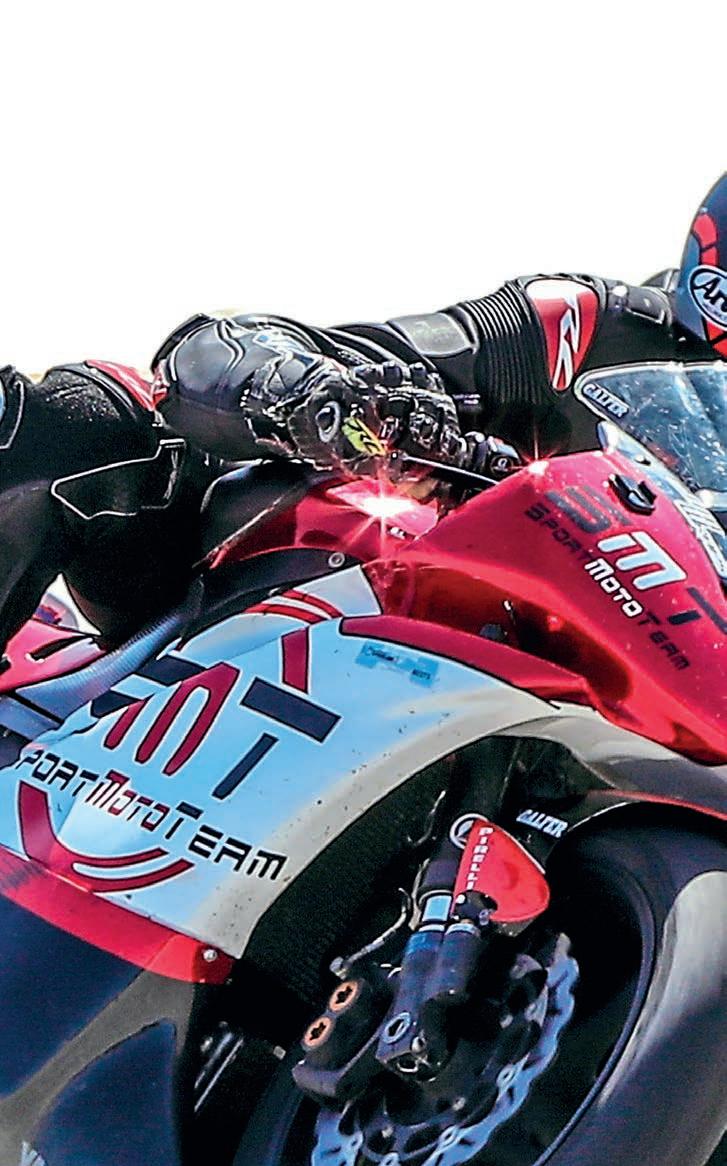

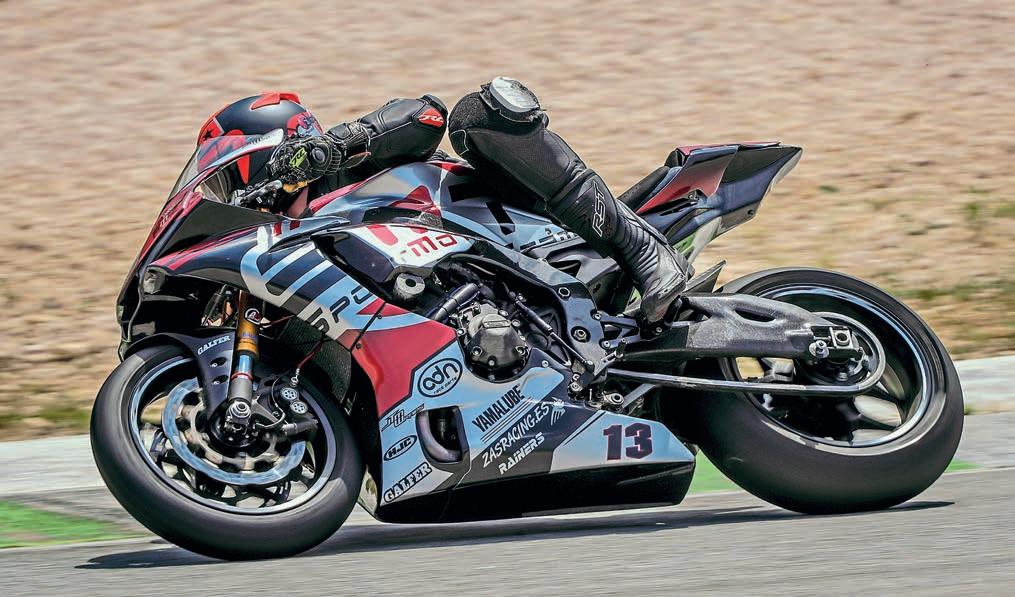

a spanner in the works? To find out, I switched from the R6 to an R1, meaning there was more weight and power for the G1310s to contend with. I think it's only fair to explain that this was my first time out on a litre bike, and I loved every second of the experience. In no time, my confidence was sky-high and I was effortlessly blasting past the braking markers put out for us, ever so slightly soiling myself, only to arrive at the corner perfectly fine.
The added pace and mass made no difference – these pads were awesome.
Come the end of the test, I’d developed absolute faith in the Galfer pads, to the extent that I started questioning whether or not to run them in my own race bike.
If you’re into your track riding, you’ll know that good brakes are about as important as it gets and I can honestly say that the G1310s are a product you can trust in. They’re not just a powerful brake pad with a strong initial bite, but they also deliver consistent performance and predictability… that is, once they’re up to temperature.
Galfer has a huge range of products to cater for typical road riding but, as I said at the start, this pad belongs on a track where you can really capitalise on the brilliance it has to offer. But before you get the best of them, they need to be up to working temperature, which is easily achieved in a lap if you give the brakes a few hard squeezes.
As compromises go, I’ll take that all day long, especially when you consider the rewards on offer.
These pads might be new, but their performance is set to make them a popular choice for track riding. Trust me.
Above: Max(ing) it out on the R1...
Below: Melandri is a driving force behind Galfer’s products.











